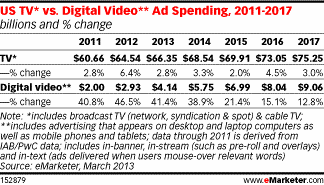Connected TV: The Death of Online Video or the Future of TV?
Connected TV has an exciting future as an extension of linear TV and online video. Although there are hurdles, marketers must find ways around them in order to drive more client success.
Connected TV has an exciting future as an extension of linear TV and online video. Although there are hurdles, marketers must find ways around them in order to drive more client success.
Connected TV is all the rage these days. Connected TV sales are up, and more than 50 percent of internet users will have a Connected TV by next year, according to eMarketer. Consumers are using connected over-the-top devices like Amazon Fire, Roku, and AppleTV to access a world of online entertainment, and every day more and more apps and services are invading living rooms in the wake of these highly tech-enabled media devices.

How Does the Proliferation of Connected TV Impact Digital Advertising and Linear TV?
Based on current research estimates, linear TV ad spend looks to remain stable over the next few years despite the growth of Connected TVs and the incremental spend in digital video.

While the Connected TV installed base is increasing, there are still a number of hurdles that are challenging the growth of Connected TV advertising as an extension of linear TV or online video.
This week, two of the largest TV buyers, GM and P&G, pulled back their TV upfront commitments for 2015. Sources say this is largely due to a shift to digital TV, including online video. P&G tends to be at the tip of the sword, directionally representing the way the market will move. We are seeing a torrid growth in requests and use of online video across the industry. As digital video spend increases, the supply of TV-quality video inventory will grow scarce, applying more pressure to find quality digital video inventory that meets the standards of TV as well as the expectations of the buyers operating the campaigns.
As the shift in spend occurs, we expect TV buyers and their agencies to require a currency for cross-measurement for easy evaluation of performance between their linear TV spend and digital video spend. Both Nielsen and comScore have established a common measure, but there are still some questions that neither has answered as it relates to cross-platform measurement that includes linear TV, online video, and Connected TVs. Outside of measurement standards, there are many format standards that need to be adopted. Today, every TV manufacturer approaches their Smart TV interface as a way to differentiate their product from the competition, which leaves app developers and service providers in a challenged situation, since most do not conform to the digital advertising standard put forth by the IAB. This causes buying friction and reduced scale. The manufacturers need to realize that their proprietary Smart TV environments need to provide a level of standardization to support a growing digital video ecosystem. Without this, linear TV will have a powerful advantage for many years to come.
In a similar vein, when most digital buyers attempt to integrate Connected TV inventory into their campaign, they are encountering another issue: attribution. Today, mobile and connected TV video inventory share this problem, since it is fairly difficult to anonymously identify a consumer across devices and inform reach/frequency models for optimization at scale. There are a number of companies working to solve these technical challenges, but many worry that privacy concerns will impede progress towards developing a common standard for cross-device identification, measurement, and targeting.
We are seeing consumer behaviors take shape within connected devices, which will have a dramatic impact on availability of online video. One of the largest TV manufacturers told me that, as you would expect, Netflix is by far the most popular service consumers access within their Smart TV. YouTube and Hulu come in second and third, followed by all the other services which lag far behind. This brings up the question of where all the advertising inventory will come from in the future, as consumers cut the cord and move these to connected devices.
The last hurdle that needs to be cleared is creative engagement. Advertisers have come to expect and enjoy the close connection they can have with consumers because of the interactivity of digital creative. In digital, the ability to directly engage, share, and communicate with a brand or product is exceptional. Connected TV inventory is great for mimicking a linear TV experience, but once the creative is interactive and buyers expect some form of further engagement, the possibilities are endless. But will the consumer pick up the remote and engage at a rate that will appeal to buyers? This will require a true change of typical viewing behavior.
Connected TV has a very bright future as an extension of linear TV and online video. Many of the trends we are following point to great things happening around a new model of converged TV. Buyers will have the ability to leverage existing TV budgets, enhance spend with new engagement models, and address consumers in new ways within large movie-like environments. While there are a number of serious challenges that must be addressed, I am confident that the industry will find ways around these roadblocks, giving life to huge opportunities for us to drive more and more client success.